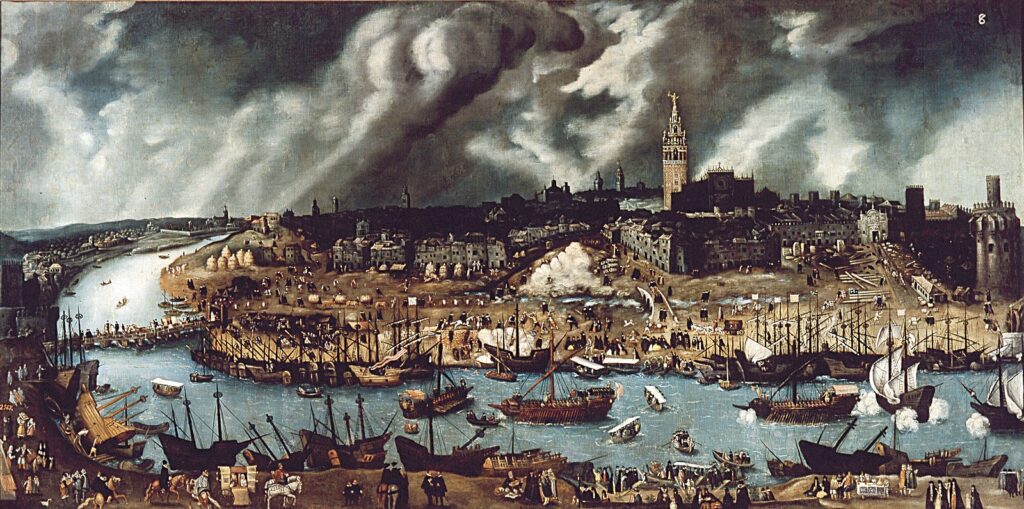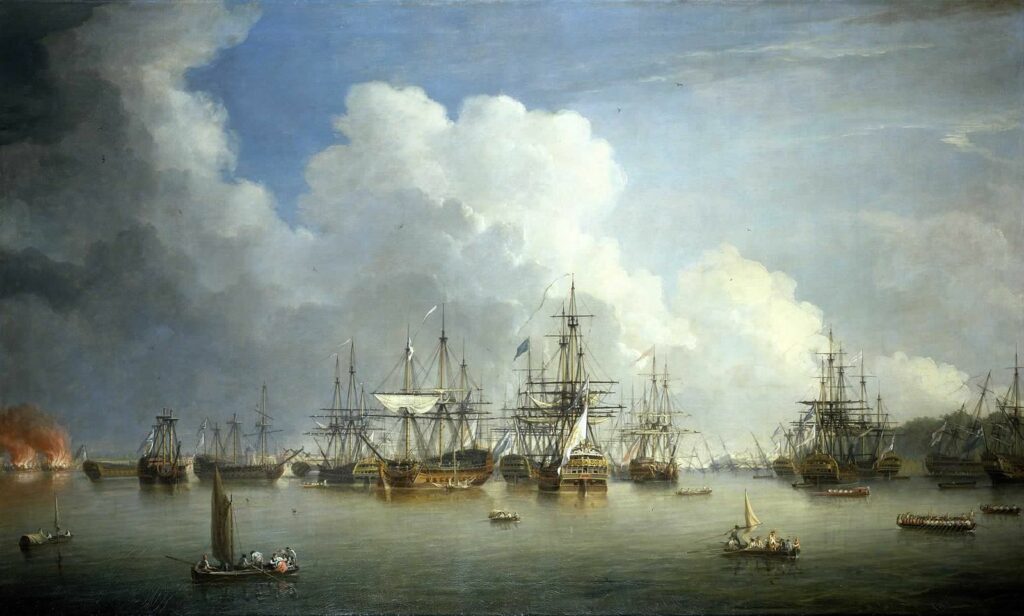The Spanish fleet was a symbol of power, wealth, and prestige. It was the foremost symbol of the greatest superpower the world had ever seen – the Spanish Empire.
For centuries, the Spanish treasure fleet, with its flotas and galeones, transported European goods to its colonies and returned with vast quantities of gold and silver.
The immense riches carried by these fleets fueled the Spanish economy and financed the expansion of its empire across the Atlantic. They also attracted the attention of pirates and privateers from rival nations.
The journeys were fraught with danger. The fleets faced storms, diseases, and attacks from sea raiders. Despite these challenges, the Spanish fleet remained a formidable force for centuries, until changes in policies and technology led to its eventual decline.
In its heyday, the Spanish treasure fleet would have been a marvel to behold.

A Treasure Trove on the High Seas
Spanish ships have been traversing the Atlantic since Christopher Columbus voyaged to the Americas in 1492
The Spanish treasure fleet – the flotas and galeones – was responsible for transporting a wide range of valuable goods.
It was responsible for bringing the Spanish Empire’s overseas territories to the mainland. This included precious metals such as gold and silver, gems, pearls, spices, and other exotic commodities.
This vast influx of wealth made many traders rich. However, the sudden increase in precious metals also caused inflation. This had adverse side effects on the Spanish economy during the 17th century.
Despite this, the Spanish West and East Indies fleets remain renowned for their success in naval operations. They played an essential role in the formation of today’s global economic system.
The convoys were critical in safeguarding the Spanish treasure trove of shipping from pirate attacks and foreign navies. The system dates back to the 1560s following the sacking of Havana by French privateers.
This event would mark the establishment of the flotas and galeones.
The Flotas Head for Vera Cruz
The Spanish flotas were an organized shipping fleet that traveled between Spain and the Americas regularly starting in the 1560s.
Typically, the massive fleet of 50 or more vessels departed from Sevilla or Cádiz to the American colonies each year. The flota would sail down the coast of Africa, stopping at the Canary Islands for provisions before making the voyage across the Atlantic.
Once in the Caribbean, the fleet made stops at the West Indies and Honduras en route to Vera Cruz, Mexico. There, they would load extraordinary amounts of silver and, commonly, red dye.
Additionally, the flotas carried back porcelain and silk that was shipped from China on the Manila galleons. These were then carried overland from Acapulco to Veracruz by mule train.
And the Galeones to Cartagena
Meanwhile, the sister fleet to the flotas – the Spanish galeones – would make a similar journey.
The galeones, also known as the Tierra Firme fleet, sailed from Spain, across the Atlantic, and into the Caribbean. However, they departed the West Indies and sailed south to Cartagena in Colombia and Porto Bello in Panama.
There, they loaded up on South American products such as silver from Potosí and Portobello. They also acquired pearls from Margarita Island.
The galeones also commonly refer to the fleets of the related and interconnected Manila galleon trade.
The first permanent trade route across the Pacific Ocean, this fleet brought goods from the Philippines and China to Acapulco. There, they would be transported to Veracruz before being taken back to Spain by flotas.
Rendezvous in Cuba
After winter, and upon completing their respective routes and collecting all their valuable commodities, the flotas and galeones fleets would rejoin one another at Havana, Cuba.
In Cuba, the treasure fleet combined their cargoes and returned to Spain together. And they did so under great protection.
Given the massive wealth they held, the Spanish fleets were heavily guarded by warships to protect them from attacks by pirates and foreign navies.
The combined value of the gold, silver, and other treasures carried by the fleets was enormous.
Individual galleon ships often carried as much as 2 million pesos worth of silver and other goods. That would amount to almost 50 million grams of silver on a single ship!
In total, Spanish trade was estimated to produce around 4 billion pesos during their operation. This equates to somewhere around a staggering $500 billion today.

Challenges for the Spanish Treasure Fleet
The Spanish treasure fleet faced significant challenges during their voyages from the Americas to Spain.
The absurd amounts of wealth in gold, silver, and other goods attracted the attention of English, Dutch, and French seamen. They all attempted to loot and destroy the fleets on occasion.
Yet, only once was a fleet completely looted and destroyed. In 1628, the Dutch admiral Piet Heyn managed to capture an entire group of flotas in the Battle of the Bay of Matanzas off the coast of Cuba.
The Spanish treasure fleet was usually able to repel such attacks. Only a handful of galleons were lost to enemies during their two-and-a-half centuries of operation across the Atlantic.
Despite this, wrecks of Spanish treasure ships remain a prime target for modern treasure hunters. Many ships were sunk by storms, with some of the worst disasters occurring in 1622, 1715, 1733, and 1750.
By the 18th century, however, Spain established stronger control over trade routes, and the security of the fleet system was no longer necessary. Thus, Spain finally put an end to the galeones in 1740 and the flotas in 1789.
Role of the Flotas and Galeones in Spanish History
The flotas and galeones were integral to the rise and dominance of Spain as a global power in the 16th and 17th centuries.
These fleets carried vast sums of gold, silver, and other commodities from the Americas. This bolstered Spain’s wealth, influence, and power.
However, their lengthy and perilous voyages across the Atlantic were often riddled with obstacles. These ranged from pirate attacks to treacherous storms. This made each journey a high-stakes gamble of risk versus reward.
The fleets were a prime symbol of the Spanish Empire, but also a target for those who sought to challenge it.
Despite their eventual decline in importance, the flotas and galeones remain an enduring symbol of Spain’s golden age and its global ambitions.
References
“Spanish Treasure Fleet.” Encyclopædia Britannica, Encyclopædia Britannica, Inc., https://www.britannica.com/topic/Spanish-treasure-fleet.
Walton, Timothy R. The Spanish Treasure Fleets. Pineapple Press, 1994.

